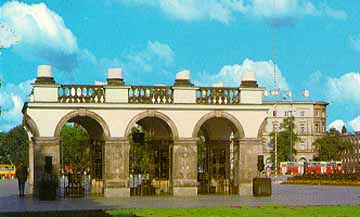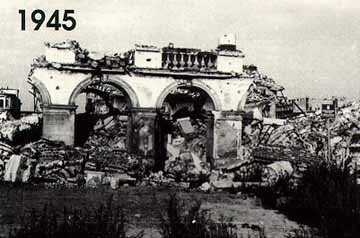Warsaw
On a trip to Poland in the fall of 1998,
my first stop was Warszawa, the Polish name for the city that
Americans called Warsaw. Warsaw is, by far, the largest city
in Poland with a population of 1.5 million. It was not, however,
the city with the largest population of Polish people in 1998,
since Chicago had 1.8 million Polish-Americans at that time.
Since the fall of Communism in 1989,
Warsaw has become so Westernized that you would think that you
were in a city in America. The names at the top of the skyscrapers
are IBM, Firestone, Goodyear, Marriott, Coca Cola, and other
American brand names. On every corner, it seems, there is either
a Pizza Hut or a McDonald's. In all the restaurants where I ate,
the menus were in both Polish and English. Everyone that a tourist
is likely to communicate with in Warsaw speaks fluent English.
A tourist is likely to have more trouble communicating with the
people in Scotland than in Poland, since the Poles speak English
without an accent. The people of Poland are extremely friendly
and respectful with Old World manners. Having heard that Poland
is a backward country, I was amazed to see so many people conducting
business on cellular phones.
For most travelers, their first view
of Poland is the airport on the outskirts of Warsaw. I traveled
on Lott, the Polish airline and almost all of the passengers
were Polish. When the plane landed, everyone applauded. The airport
is quite small, more like the Shannon airport in Ireland than
like some of the other international airports in Europe. All
airport signs are in both English and Polish, so one needn't
worry about getting lost or confused here.
The route from the airport to the city
of Warsaw has a two-mile stretch of road lined with beautiful
linden trees which is quite an impressive sight, especially in
the Fall when the leaves have changed color. Along this road
is a very formal entrance to a graveyard where Russian soldiers,
who died on the battlefields to liberate Poland from the Nazis,
are buried. Immediately, you are aware of history the minute
you enter Poland.
I stayed at the Hotel Europejski, which
is the oldest hotel in Warsaw, opened on Jan. 1, 1857, and is
exactly what you would expect for a hotel built in 1857. There
is a Polish military building across from the front entrance
and The Tomb of the Unknown Soldier, behind a very large plaza
called the plac Pilsudskiego, is on one side of the hotel. Soldiers
guard the tomb around the clock and every hour there is a changing
of the guard with a special ceremony at 12 noon every Sunday.
I got there just in time for the noon ceremony and saw Polish
veterans from World War II dressed in their uniforms.
 Tomb of Unknown Soldier
after it was restored
Tomb of Unknown Soldier
after it was restored
Inside the building where the tomb of
the unknown soldier rests, there are inscriptions on the walls
commemorating battles fought by the Poles from 972 to 1945. A
couple of German tourists standing next to me pointed out the
inscription for the Battle of Grunwald in 1410. This was the
decisive battle in which the Poles and the Lithuanians teamed
up to defeat the German Teutonic Knights, a religious military
order. The Christian Poles needed the protection of the Teutonic
Knights in their fight against the pagan Prussians, who were
then Slavic people, and the Lithuanians, who were also pagans.
The old photograph below shows the Tomb
of the Unknown Soldier, erected in 1925, as it looked in 1945
after it was damaged during World War II. The photo above is
a postcard which shows it as it looks today, after being rebuilt.
 Tomb of Unknown Soldier
in Warsaw during World War II
Tomb of Unknown Soldier
in Warsaw during World War II
Behind the Tomb of the Unknown Soldier
is Warsaw's first park which was designed by English gardener
James Savage in 1727 with formal landscaping. The park is quite
extensive, being almost as large as Old Town. Called Saxon Park,
it was originally the grounds of the palace for King Augustus
II, who was German and was also the Elector of Saxony, a province
in Germany. He was nicknamed Augustus the Strong because of his
physical strength and his legendary sexual prowess. There were
actually two Saxon kings, as his son Augustus III succeeded him.
Right away, you begin to understand why the Nazis thought of
Poland as the "German East".
|